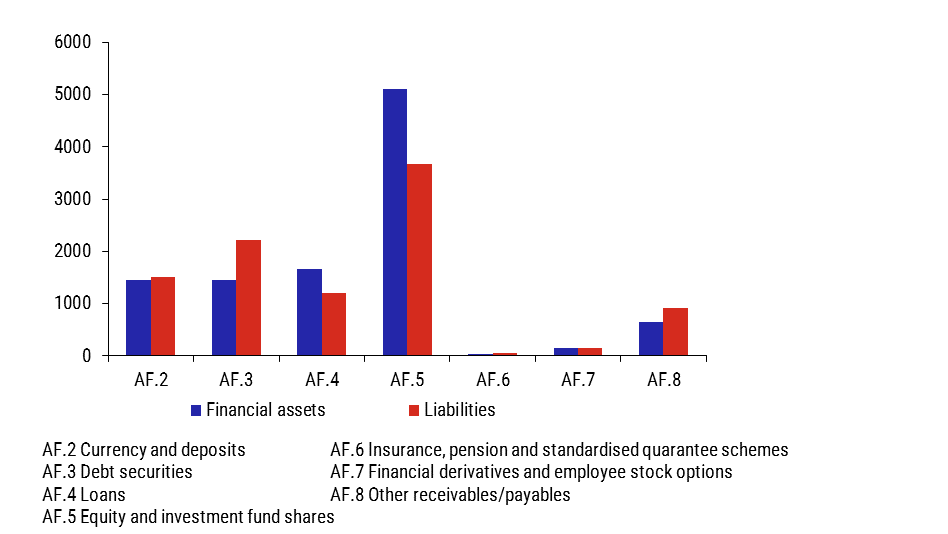Financial accounts statistics – commentary
for 4Q 2023
The overall situation
The total value of the financial assets in the Czech economy rose by 1.1% in 2023 Q4. This represented a year-on-year increase of 4.1%. The total value of financial assets was favourably affected by their revaluation totalling CZK 228.2 billion. The value of financial assets rose by a further CZK 221.9 billion as a result of transactions. Other changes (CZK 80.0 billion) also acted in the same direction. All economic sectors except financial corporations contributed to various extents to the growth in financial assets and liabilities. The rest of the world again recorded an increase in financial assets, one that was substantially bigger than in the previous quarter. This was followed by households. However, the growth in their financial assets was only one-half of that recorded a quarter earlier. Following four quarters of decline, non-financial corporations also recorded an increase in financial assets. The growth in the value of the financial assets of general government was slightly above the Q3 level. The financial assets of financial corporations were slightly below the Q3 level. The liabilities side was dominated by general government. They were followed by the rest of the world and, some way behind, by non-financial corporations and households. Financial corporations recorded a decline in liabilities following three quarters of growth.
The shares of the individual financial instruments in total financial assets and liabilities recorded less pronounced changes than in the previous quarter. The share of total deposits stayed at the previous quarter’s level, but changes in their structure were reflected in the most significant change in shares of the individual financial instruments (1.6 pp for transferable deposits and -1.8 pp for other deposits). However, the size of the observed shifts is broadly in line with the monitored long-term quarterly changes typical of the last quarter of the year. The share of long-term debt securities and shares in investment funds in total financial assets and liabilities increased (0.5 pp and 0.3 pp respectively). By contrast, the share of financial derivatives decreased again (-0.5 pp). The share of short-term debt securities decreased by 0.4 pp due to a significant quarter-on-quarter transaction decrease in their value (-43.2%). Turning to the sector structure, the share of financial corporations decreased on both sides of the financial balance sheet. On the financial assets side, this was in favour of a slight increase in the shares of the remaining economic sectors. On the liabilities side, the share of financial institutions declined in favour of general government and non-residents.
Chart 1 – Breakdown of financial instruments in the economy
(in %)
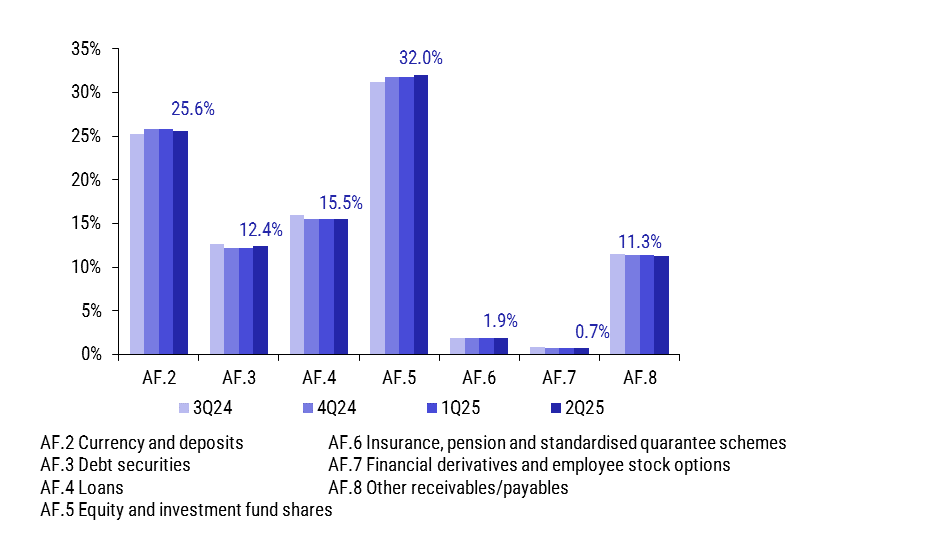
Chart 2 – Breakdown of financial assets and liabilities by sector
(in CZK billions)
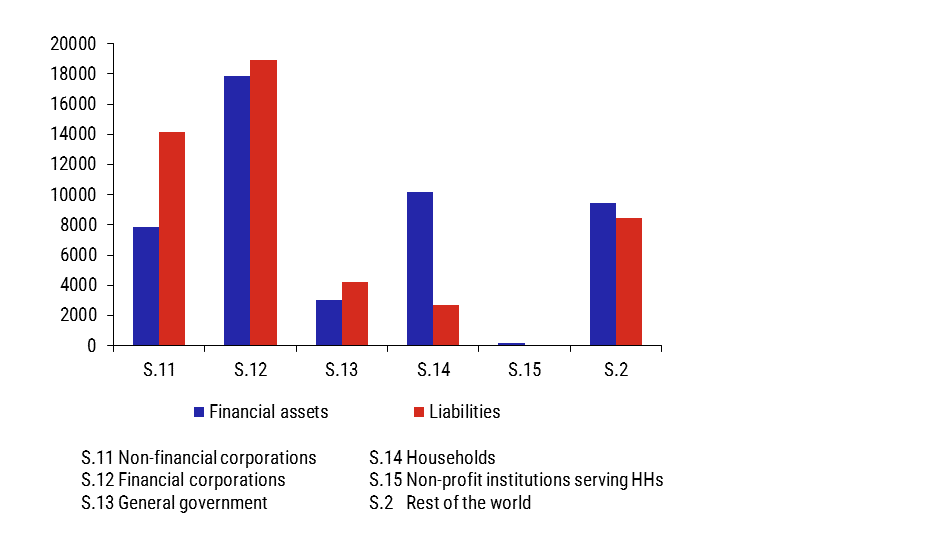
Households again strengthened their net creditor position. However, growth in net financial assets was much smaller than in the previous quarter. Financial corporations recorded an improvement in their net financial position for the third consecutive quarter. The relatively sharp decline in the negative net financial assets of the central bank played a crucial role here. The net debtor position of non-financial corporations also decreased. By contrast, the negative net financial assets of general government grew considerably. The net creditor position of the rest of the world weakened for the third consecutive quarter.
Non-financial corporations
An increase in the growth rate of financial assets (from -0.4% to 1.7%) amid an only slight increase in liabilities (0.3%) was reflected in an improvement in the net financial position of the sector. The value of negative net financial assets decreased by 1.4% due mainly to positive market revaluation. Financial transactions and other changes were of less significance.
Financial assets were affected by growth in transferable deposits with commercial banks. The growth in the value of other equity was determined by other changes consisting in a change in sector classification (a shift from households). Unlisted shares primarily reflected the increase in transactions. The value of trade credits increased as well. The contrary movement in the term structure of loans was reflected in their value, which was the same as a quarter earlier. The increase in foreign and intra-company loans was crucial for growth in short-term loans. The decline in long-term loans reflected a decrease in loans provided within the sector. The growth in financial assets was significantly dampened by a decline in financial derivatives and other deposits with commercial banks. The liabilities side was affected mainly by a non-transaction increase in unlisted shares in the form of other changes (sectoral change vis-à-vis captive financial institutions). The value of loans, especially loans from abroad and intra-company loans, increased further. By contrast, the value of financial derivatives decreased due to negative revaluation.
Turning to the structure of the balance sheet, financial derivatives decreased on both its sides (-1.6 pp and -0.7 pp respectively). On the financial assets side, the proportion of shares and other equity and deposits increased. The share of loans and shares and other equity increased on the liabilities side.
Chart 3 – Breakdown of financial assets and liabilities of non-financial corporations
(in CZK billions)
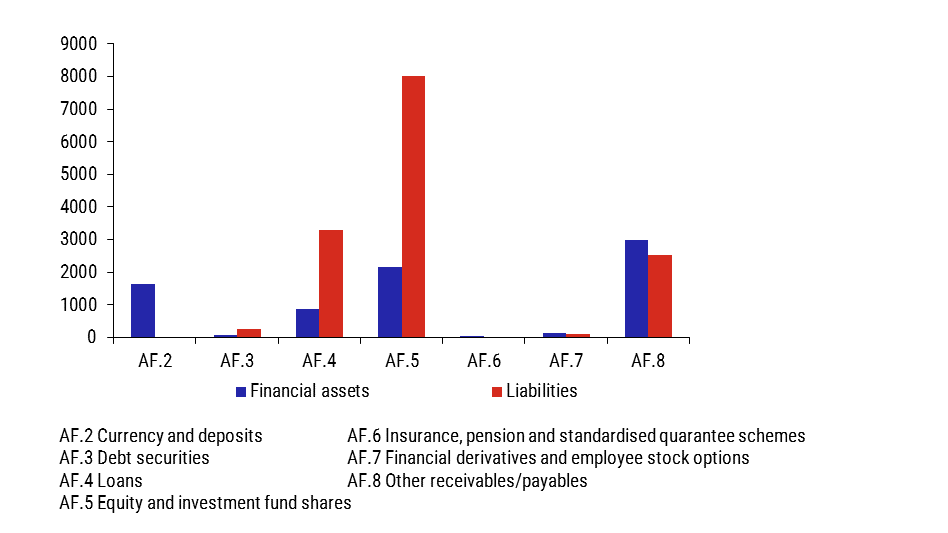
Financial corporations
A slight drop in liabilities (-0.7%) accompanied by virtual stagnation in the total value of financial assets (-0.1%) led to an improvement in the net financial position of financial corporations. The decline in negative net financial assets (8.9%) was affected mainly by positive net other changes and, to a lesser extent, by financial asset revaluation. Net financial transactions were negative.
The value of financial assets was negatively affected by a significant decline in other deposits. The value of financial derivatives decreased due to revaluation. The drop in the value of unlisted shares was due to non-transaction changes. Conversely, short-term debt securities recorded a solely transactional decline in value. The decrease in financial assets was dampened by growth in other financial instruments, primarily transferable deposits. Long-term debt securities and loans also went up in value. The value of listed shares and other equity increased due mainly to non-transaction changes. The decrease in liabilities was due to a drop in the value of other deposits, short-term debt securities and, owing to other changes, unlisted shares. The value of financial derivatives also fell again. The drop in liabilities was partly offset by growth in the value of transferable deposits and shares in investment funds.
As regards sub-sectors, the largest improvement in the net financial position was recorded by the central bank due to higher growth in financial assets than in liabilities. The financial assets side was favourably affected by the revaluation of long-term debt securities and listed shares and a transaction increase in deposits. The increase in the value of financial assets amid virtually flat liabilities led to an improvement in the net financial position of financial auxiliaries. A much higher decline in liabilities than in financial assets led to an improvement in the financial position of captive financial corporations. The higher growth of financial assets than liabilities led to improvements in the financial position of insurance corporations and pension funds. By contrast, deposit-taking corporations except the central bank, other financial intermediaries and collective investment funds showed a deterioration in their financial position.
Chart 4 – Shares of sub-sectors in financial assets and liabilities of the financial sector
(in %)
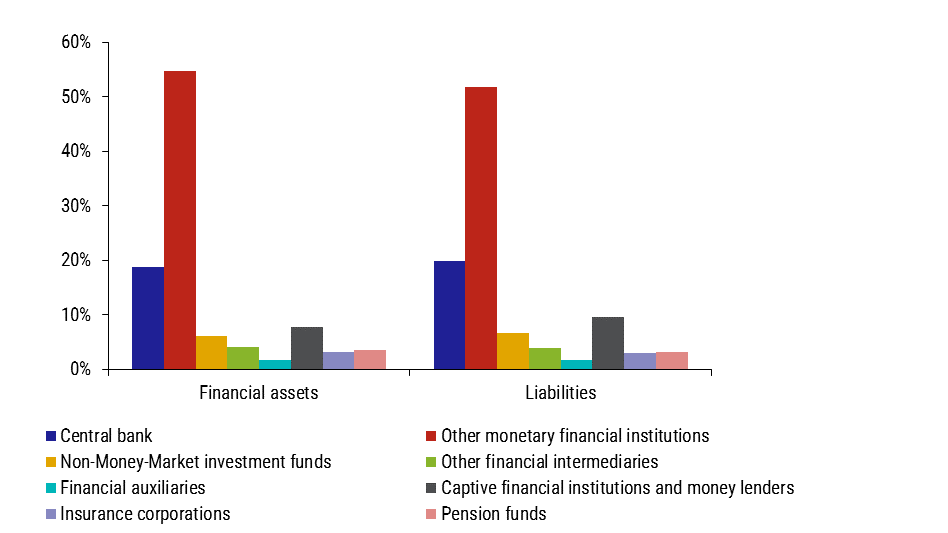
Chart 5 – Breakdown of financial assets in selected sub-sectors of the financial corporations sector
(in %)
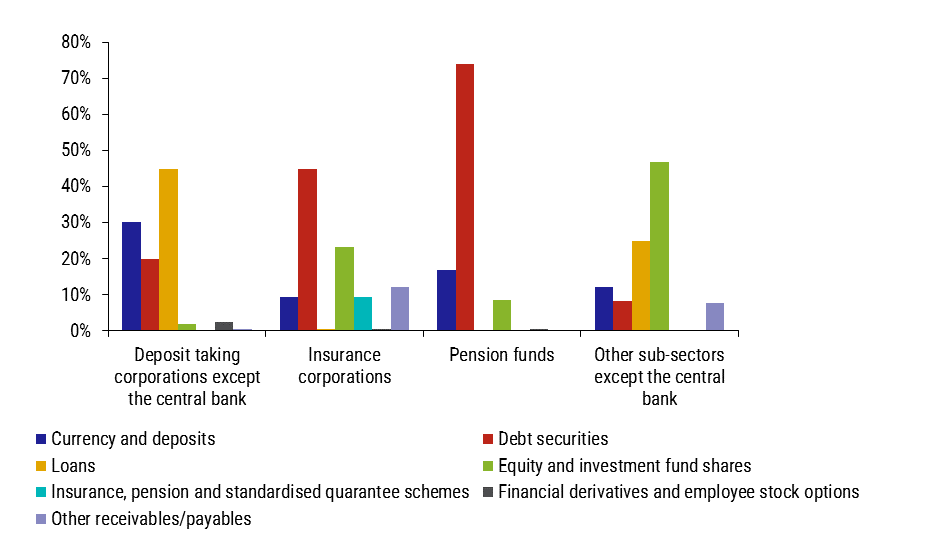
General government
Substantially higher quarter-on-quarter growth in the value of liabilities than financial assets (8.3% and 2.7% respectively) led to a significant increase in the sector’s debtor position. Growth in negative net financial assets (of 26.2%) was affected to almost the same extent by negative net financial transactions and the revaluation of financial instruments. All three sub-sectors recorded a deterioration in their net financial position to varying degrees.
The value of financial assets was affected mainly by a transaction increase in transferable deposits with the central bank and within general government, so the impact on the liabilities side was similar. Growth in loans was driven by a rise in long-term loans, which primarily reflected transactions within the sector. The value of unlisted shares increased due to revaluation. The growth in financial assets was dampened by a decline in the value of other deposits with commercial banks. The value of short-term debt securities also declined. Other financial instruments had only a marginal effect on the value of financial assets. The liabilities side was affected mainly by an increase in transferable deposits within the sector. The substantial revaluation of long-term debt securities held by non-residents affected growth in their overall value. Growth in long-term loans reflected to a comparable extent an increase in loans provided within the sector, loans from abroad and loans provided by domestic non-financial corporations. The growth in liabilities was partly offset by short-term loans (repayment of loans from abroad) and short-term debt securities.
Chart 6 – Breakdown of financial assets and liabilities of general government
(in CZK billions)
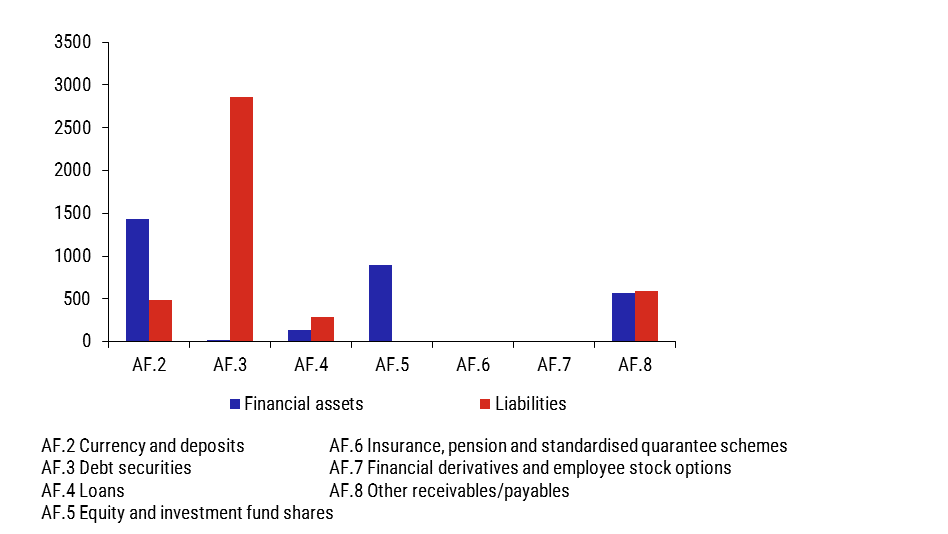
Households
Net financial assets increased in value by 1.5% quarter on quarter amid growth in both financial assets and liabilities (of 1.4% and 1.2% respectively). Net financial assets were favourably affected by financial transactions and to a lesser extent by financial asset revaluation. The effect of other changes associated with a change in sector classification acted in the opposite direction.
The financial asset side was positively affected by substantial growth in the value of shares in investment funds. Both domestic and foreign funds increased in value. The inflow of new client funds increased significantly compared to the previous quarter. Non-transaction changes in the form of market revaluation and other changes also had a positive effect, albeit to a smaller extent. Deposits, both transferable and other, continued to grow. The value of shares rose due almost equally to transactions and revaluation. From a long-term perspective, relatively high growth was recorded in the value of long-term debt securities for the second consecutive quarter. In the previous quarter, the increases were solely as a result of market revaluation, whereas the current increases were due to transaction growth. The increase in financial assets was substantially offset by a decline in the value of other equity due to other changes (a change in the sector classification). The modest quarter-on-quarter pick-up in growth in liabilities was as a result of an increase in loans provided by key deposit-taking corporations except the central bank (from 0.9% to 1.3%). The breakdown of loans was unchanged, with long-term loans accounting for the largest share (98%).
Chart 7 – Breakdown of financial assets and liabilities of households
(in CZK billions)
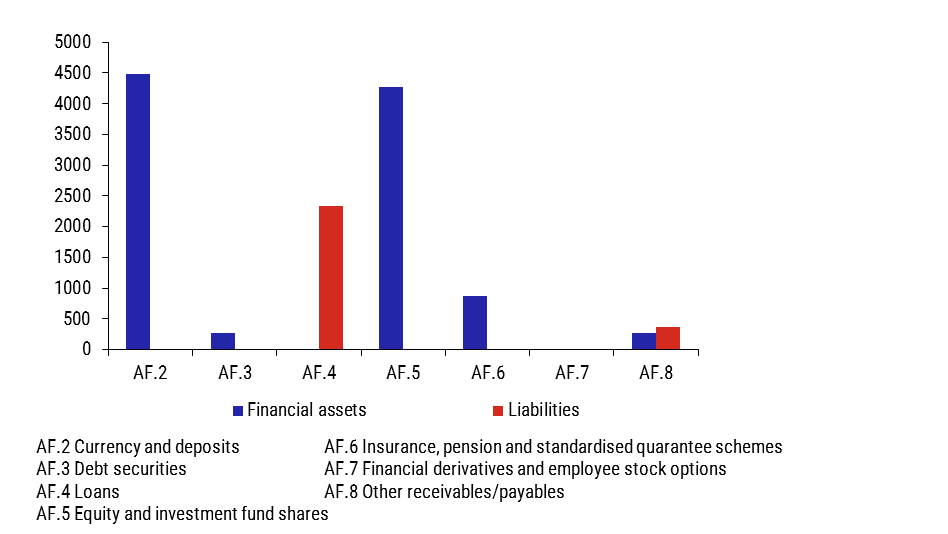
Rest of the world
Higher quarter-on-quarter growth in liabilities than financial assets (2.2% and 3.2% respectively) led to a further decrease in the value of net financial assets for the third consecutive quarter. Their quarter-on-quarter decrease of 6.1% was due to non-transaction changes and, to almost the same extent, negative revaluation and other changes. This was only partly offset by a surplus on financial transactions.
As regards financial assets, the largest increase was recorded in the value of deposits due to the transaction increase in other deposits received by commercial banks from abroad. Growth in loans was driven by a rise in long-term loans to non-financial corporations and general government. The decrease in short-term loans was due to the repayment of loans to general government. Growth in the value of shares and other equity was affected by transactions and other changes. From the long-term perspective, shares in investment funds recorded significant growth in value due in almost equal measure to transactions and other changes. The slight decrease in the value of debt securities was accompanied by dynamic changes in their structure. The decline in short-term debt securities reflected a sharp transaction decrease in domestic bank bonds owned by non-residents. The increase in the value of long-term debt securities was affected especially by the revaluation of government bonds. Financial derivatives and trade credits provided to domestic non-financial corporations recorded a transaction decrease in value. The growth in liabilities was due to a rise in the value of shares and other equity, due to transaction and non-transaction changes. The value of long-term debt securities held by the central bank rose significantly due to revaluation. The value of short-term loans to non-financial corporations increased following the decline observed four quarters in a row. The slight drop in the value of deposits was as a result of contrary movements in the form of growth in the central bank’s transferable deposits abroad accompanied by a decline in their other deposits. The liabilities side was further negatively affected by a drop in the value of financial derivatives.
The changes in the values of the individual financial instruments were reflected in the structure of the financial balance sheet. On the financial assets side, the proportion of financial derivatives and shares and other equity decreased in favour of deposits. On the liabilities side, a drop in the share of financial derivatives and deposits led to a rise in the contribution of shares and other equity.
Chart 8 – Breakdown of financial assets and liabilities of the rest of the World
(in CZK billions)
